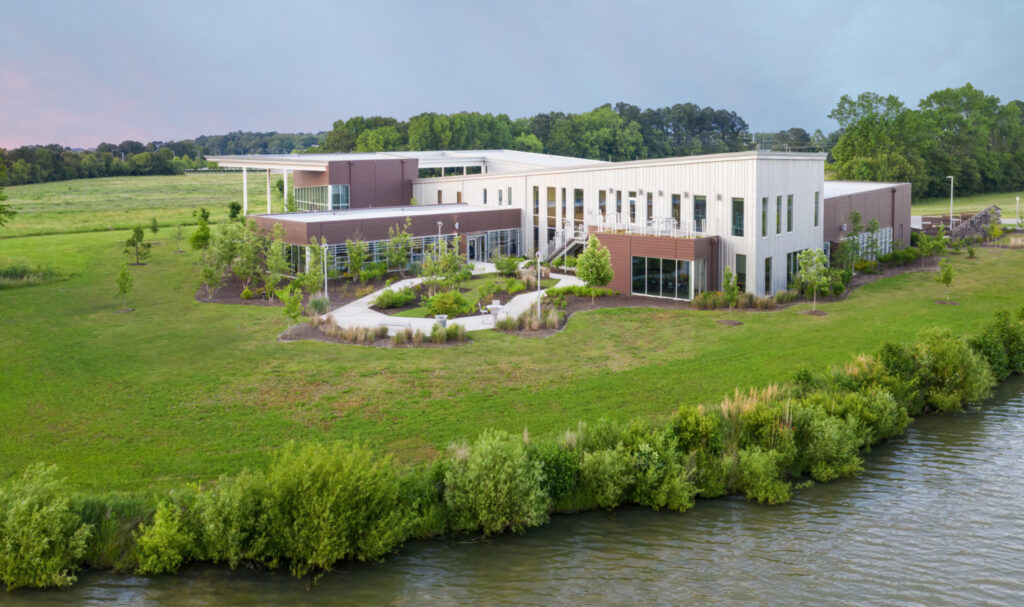Recreation centers used to be highly programmed places. Pools, gyms, basketball courts, tennis courts, handball courts, playgrounds, ball fields, changing rooms, and offices—all defined spaces for specific activities. More meant more. The good ones were regularly maintained and became community hubs. The not-so-good ones were easy to spot because of their shabbiness, usually because of the cost of maintaining “more.”
The mathematics of the ideal recreation center have changed recently, however, measured less by how intricately they’re programmed and more by how adaptable they can be. It would be too obvious to say “less is more” here, but the fact is that the less programmed today’s recreation centers have become, the closer they have gotten to actually accommodating community needs, which privilege flexibility over fixed amenity.

Administering all of these needs is a separate challenge altogether. In 2020, VIA Design Architects completed the Virginia Beach Parks and Recreation Administration Building, which consolidates multiple offices from around town and facilitates Virginia Beach’s sustainability goals of environmental stewardship, social responsibility, and economic vitality.
Locally, the project arrives at a critical time for Virginia Beach as it recovers from COVID-related rec center closures and, now that they’re back open, current and future staffing shortages. Operating seven physical centers, accommodating dozens of after-school and weekend classes (from archery to martial arts to swimming), and hosting birthday parties is as much of an infrastructural challenge as it is an administrative challenge.
Regionally, the project is part of a spate of cities upgrading their facilities to meet greater demands and a higher standard of green including Moseley Architects’ LEED Sliver Patrick Henry Recreation Center (and PreK-8 School) for Alexandria, completed in 2000, and iStudio’s LEED Gold Marvin Gaye Recreation Center for DC, completed in 2018.
In plan, the building’s main axis is composed of two long volumes that saddle up to each other and contain common areas, break-out spaces, circulation, and offices. In elevation, the dramatic slopes of each axial volume creates opportunities for a variety of spaces inside from airy to intimate. The central atrium where the slopes intersect includes a grand staircase that doubles as risers for all-staff assemblies and accommodates a small conference area beneath it. VIA Design Architects situated the building to conserve 65% of the site for open space (not to mention pollinator plantings), and more than half the site supports habitat low impact maintenance strategies and habitat restoration.

The building maintains a consistent temperature and energy usage thanks to 70 geothermal wells buried beneath the parking lot, which exchanges heat in the summer and absorbs heat in the winter. Solar shades on the exterior and roller shades on the interior offer occupants more control in adjusting for heat or glare. In its first year, the city realized $10,000 in energy savings through a 20% reduction in energy usage and a 32% reduction in potable water usage. Over the lifetime of this building — let’s say 30 years for the sake of argument — that’s $300,000 in savings minimum on just the utility bill alone.
There’s another metric that counts here, too. This year, the American Academy for Park and Recreation Administration named the city’s parks and rec department as a finalist for the National Gold Medal Awards for Excellence in Park and Recreation Management. VIA Design Architects refers to notable projects in its award winning portfolio as case studies. If the new home of parks and rec has anything to do with the management of its facilities, then as case studies go, this project might be in a category by itself, blending a design process with architect-driven results.
About the author
William Richards is a writer and editorial consultant based in Washington, D.C. From 2007 to 2011, he was the Editor-in-Chief of Inform Magazine.
